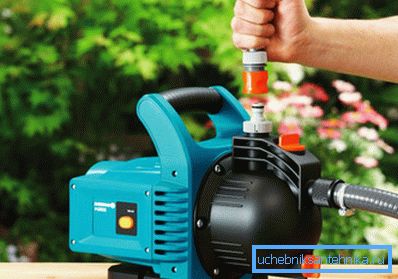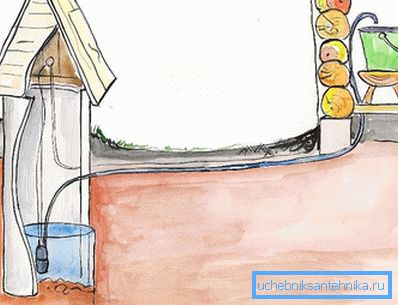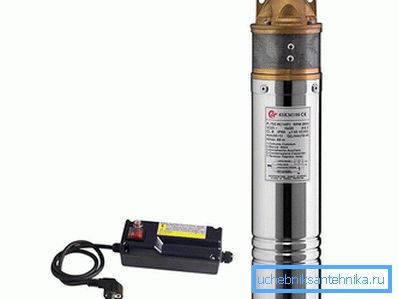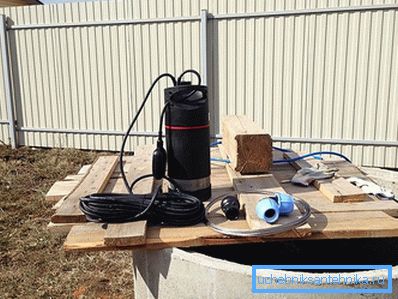How to choose a pump for a well
Water in the house is the inalienable benefit of civilization. The owners of private homes are trying by all means to provide for themselves. If the central water supply line passes nearby, the problem is solved by connecting to it. Of course, this is not easy, but achievable. And what to do in the event that the water source is a well or a well? For pumping water from such sources are electric pumps. But to ensure quality water supply, you need to know how to choose a pump for a well..
Overview of pumps for pumping water from the well

For water supply of a private house or cottage from a well, different types of pumps are used. So, the pumps are divided according to the principle of installation:
- surface;
- submersible.
The surface pump is installed in such a way that water does not fall on it. Therefore, they are mounted above the water level, preferably in the room. Water is taken from a well through a special hose. Thus, this unit can stand both near the place of water intake and at a distance. Another positive aspect is the simplicity and accessibility of service, because the pump is on the surface. Moreover, with its year-round use and installation in the room it is not necessary to warm it for the winter. The main disadvantage of the surface pump is that the water that enters the unit must be clean. At hit of dirt the pump quickly becomes littered and fails. Another unpleasant moment is the shallow depth of water pumping. These pumps are used at a well depth of not more than 9 m. To increase the depth, external ejectors are additionally installed.

Submersible pumps, judging by the name, work in the water. They are designed to pump water directly from the depth of the source. The immersion depth is limited by the distance to the bottom - it should be more than 30 cm. If you lower the pump closer to the bottom, then sludge, sand or other particles raised from the bottom by swirling water will impair the pump, although these models are resistant to blockage. The cooling of the unit during operation takes place with the help of water in which it is immersed. The lack of submersible pumps is that they cannot work in the absence of water. Without liquid, they quickly burn out, so the idle function is provided in the design of the pumps. This means that if at the time of operation the unit is on the surface, then its operation will automatically stop.
There are pumps and on the principle of pumping water:
- vibrating;
- dynamic.

Vibration pumps work in this way: water is taken in by the reciprocating motion and then released into the feed pipe. The first stage: with the help of a vibrator acting in one direction, liquid enters the water intake chamber. Stage two: vibratory movements directed in the opposite direction create pressure, which closes the intake valve and pushes water into the supply pipe. The advantage of this type of unit is insensitivity to voltage drops and the degree of water purity.

Dynamic pumps are mainly centrifugal. The principle of their work is that inside the pump chamber there is one or more blades. It is their rotation that creates the movement of fluid in a given direction. If there is one blade in the pump, then such pumps are called single-stage. Units with several blades are multistage pumps that give a higher power head.
Criterias of choice

In order to get the desired result, you need to know which pump to choose for your needs.
- It is necessary to decide for what purposes the pump will be used. If only for irrigation and technical needs - it will be one model of the pump, and if for a full water supply at home, then it is a completely different type of pump. Another important role is played by the seasonality of the use of the unit: only in the warm season or year-round;
- Based on the purpose of the pump, determine the amount of water. There are consumption rates, for example, per person for a shower is 250 liters per day, for washing hands - 5 liters per day, etc. In order not to experience inconvenience when all water consumption points are simultaneously included, the entire estimated consumption is summed up.
- The required water pressure is calculated as follows: for every 10 m of the length of the water supply system, one meter of pressure is lost. In addition, the smallest level of pressure is equal to the vertical distance from the highest point of the water supply system to the pump installation point. One-fifth of the total system length and another 10–15 m are added to this value.
- Select a pump type. The location of its installation depends on it.
- Determine what the water level in the well and what the distance from the edge of the well to the surface of the water. It is very important how deep it is to lower the water intake pipe or immerse the pump.
Having determined these parameters, it is necessary to carefully study the characteristics of the pump according to the passport data and compare all these data. Thus, you can select the desired pump model.
Video
Listen to tips on how to choose a well pump:
This video is about pumps for the grundfos well of the sq 3-105 series; 2-55 kp 150: